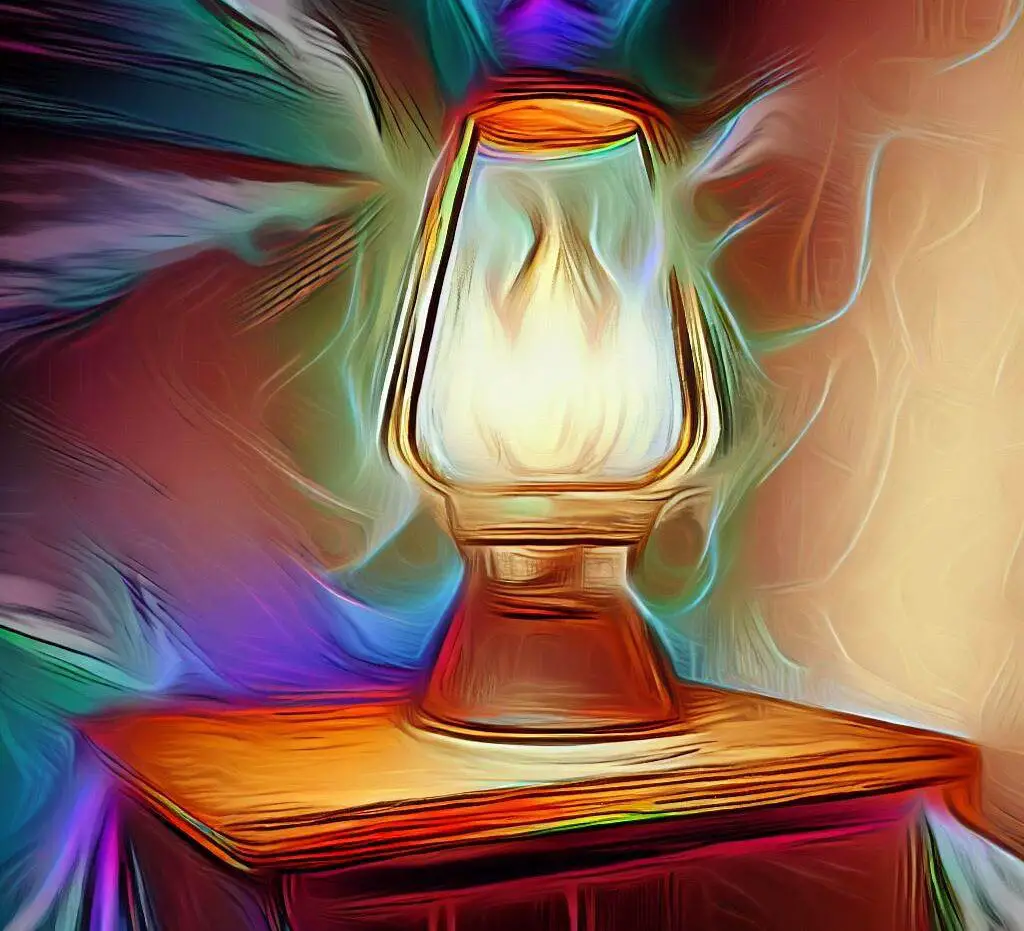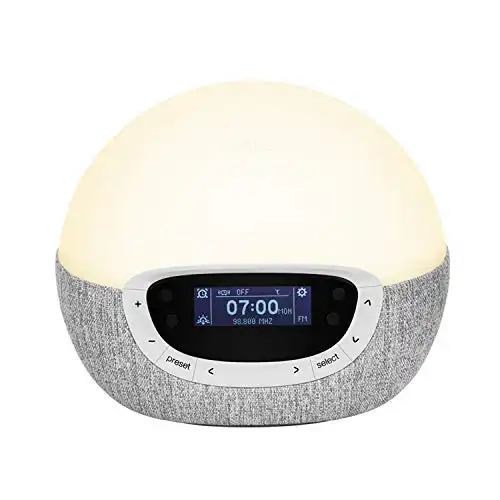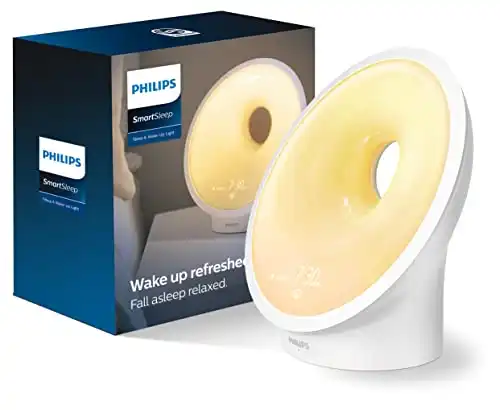Lumie Bodyclocks are well-designed sunrise alarms from the company that pioneered wake-up light technology decades ago. The Bodyclock Rise 100 is lacking high-end features, but provides great overall value. The Lumie Glow 150 is a quality mid-range option. And the Shine 300 is feature-packed and can compete with any sunrise alarm on the market today.
Philips, as you can imagine, makes great lights. But the design and functionality of the Philips SmartSleep is disappointing. All three products are awkwardly designed, and have significant design flaws (like alarms that can’t be silenced).
Features
The Lumie sunrise alarm product line is much easier to understand than the Philips SmartSleep sunrise alarm lineup. Lumie Bodyclock Rise 100 is an entry-level device, Bodyclock Glow 150 is a step up, and Bodyclock Shine 300 is a step higher still. Lumie also makes a Bodyclock Spark 100, Bodyclock Luxe 700FM, and Bodyclock Luxe 750DAB, but these are less popular and harder to find in the U.S. (where the majority of our readers reside).
All Lumie Bodyclock models have some features in common. The Rise 100, Glow 150, and Shine 300 all have a sunrise alarm with adjustable final light intensity, a physical snooze button, and an auto-dimming display. Also, each device has a clock that can be set to turn entirely off when the room is dark.
Lumie Bodyclock Rise 100 and Glow 150 lack programmable 7 day alarms. So, you will need to set the alarm each day to activate the sunrise for the next morning. The Bodyclock Shine 300 has a daily and weekly recurring alarm, so you can set alarms for the whole week and then not worry about missing a wakeup.
If you want more sound options, you will also need to look at the higher-end Lumie devices. The Bodyclock Shine 300 has a built-in FM radio and sound machine, while the Glow 150 has only a simple sound machine, and the Rise 100 has no sound at all.
The Philips SmartSleep line has many different models, all with confusingly similar names that make it challenging to keep one product separate from the others. If you don’t believe me, I can give multiple examples of professional tech writers that have published incorrect information because they confused one product with another.
The base model in the Philips SmartSleep line is the Philips Wake Up Light HF3500/60, also called Wake-Up Alarm Clock with Sunrise Simulation. Philips also makes this same product with a built-in FM radio and a couple nature sound options. This version is called the Philips Wake Up Light HF 3505/60, and also the Philips Wake-Up light Alarm Clock with Radio.
The next product in the sunrise alarm line is the Philips Wake-Up Light Therapy Alarm Clock HF3520/60. This is the mid-range Philips SmartSleep option.
On the high-end, there is also a Philips SmartSleep Sleep & Wake-Up Light HF 3650/60. And this same product also comes in a connected version, which includes an app, and is called the Philips Sleep and Wake-Up Light Therapy Lamp HF 3670/60. To further complicate the matter, this high-end, app-connected product was previously called the Philips Somneo. So, even though it has been renamed, it is still often referred to as the Philips Somneo. (Confused yet?)
In an attempt to simplify things, we will refer to these products as a Philips SmartSleep “base model,” “mid-range,” and “high-end.”
The Philips base model features a sunrise alarm, but no sunset feature. So it is a wake-up light only, and doesn’t help you fall asleep. Additionally, the audio alarm (think of the old-school beep beep beep alarm) cannot be silenced. So, even if you can wake up to a peaceful sunrise alarm alone, you will still be blasted with a beeping alarm along with it. This is true on the version that includes an FM radio, also. (If this feature bothers you, there are numerous online tutorials that show you how to punch out or otherwise destroy the product’s speaker).
On the Philips mid-range product, you can turn the sound off and use it as a stand-alone sunrise alarm. This is a great (and obvious) feature. It also has more brightness options, and includes an auto-dimming feature.
On the high-end Philips SmartSleep, you can choose between an app-connected version or a version with no app. By upgrading to the top-of-the-line Philips, you gain access to relaxation sounds, and the ability to charge a phone via a built-in port. These sunrise alarms have multiple color options for the sunrise, breathing routines, a sunset feature, and more brightness settings than the cheaper models.
Features winner: Lumie (more features comes standard on all models)
Design
Lumie has a design that is similar between all of its products. It is stylishly designed, with rounded edges and a vivid clock face. The Shine 300 achieves a more refined look by replacing a plastic base (which is seen in the Rise 100 and Glow 150) with a fabric material that makes the device look very similar to the Hatch Restore (see our reviews of the Hatch Restore here or here). It is also about 3 ounces heavier than the other Lumie models, and feels more stable. With the lightweight, all plastic construction of the Rise 100 and Glow 150, we noticed that it took two hands to use — one hand to press buttons, and the other to stabilize the device.
We liked the functionality of the physical snooze button (some sunrise alarms lack this button), but other aspects of the Lumie design were lacking. The design felt somewhat cheap, especially the buttons, which were clumsy. And to turn off the light, you have to keep pressing the dimmer button repeatedly. The power failure backup also didn’t provide much benefit, other than to keep the clock on for a few minutes after losing power.
If it matters to you, both Lumie and Philips are made in China.
While all Lumie models are similarly designed, Philips went in wildly different directions with its SmartSleep products.
Philips SmartSleep base model (HF3500/60 Wake-Up Light Therapy Alarm Clock) looks like a saucer or an early-2000s CD player alarm. Philips mid-range (HF3520/60) just looks like an oversized light bulb. As you can imagine, the device is clumsy to work with and prone to rolling off a nightstand when bumped. Philips SmartSleep high-end (HF3650/60 & HF3670/60) look like an illuminated toilet seat, and the light has a hole in the middle of it for some baffling reason.
None of the Lumie or Philips SmartSleep products allow for bulbs to be replaced, so the device is ruined when the bulb dies. However, these lights all have a rating that expects 16,000+ hours of use. Although we don’t like this, it is actually typical for sunrise alarms to have bulbs that cannot be replaced.
The base model Philips has no battery backup, feels very cheaply made, and has an ugly and dated-looking clock display. Also, the clock cannot be turned off entirely, but only dimmed.
The mid-range Philips has a battery backup, but one that doesn’t add much function to the device. The buttons are clumsy to use, and (as mentioned above) the device has an awkward shape that makes it easy to knock over. Like the cheaper Philips, the clock cannot be turned off entirely, only dimmed.
The high-end Philips has a stronger battery backup that is more functional, and also features an aux port that allows you to use the device as a speaker. However, the functionality here is lacking, and it isn’t possible to set your own music as a wake-up tune. We also found the touchscreen display to be finicky and challenging to use. A final complaint — if you wake up before your alarm, there is no easy way to turn the alarm off. Instead, you have to navigate through menus to disable the upcoming alarm.
Design winner: Lumie
Sound
For both Lumie and Philips, you really get what you pay for when it comes to a speaker.
Lumie Bodyclock Rise 100 offers no sounds except for a beeping alarm. The alarm sound quality is poor, also.
Lumie Bodyclock Glow 150 has a sound machine for wake-up and bedtime, but the sound machine shuts off when the sunset mode is completed. The Glow 150 includes 10 sounds, so you have some freedom to find a sound you like.
Lumie Bodyclock Shine 300 has a sound machine with 15 wakeup sounds, and also offers a built-in FM radio. The sound quality tests better than the Glow 150.
Philips base model offers a beep alarm only, which increases gradually in volume. The worst feature, as mentioned above, is that the beep alarm cannot be disabled. So, there is no way to use the sunrise light alarm without an audio alarm also. The sound is also very jarring (picture an old-school hotel room alarm clock). The upgraded version of the Philips base model (HF3505/60) adds an FM radio and 2 nature sounds, but is otherwise the same product.
Philips mid-range includes an FM radio and 5 nature sounds for wake-up.
Philips high-end includes relaxation sounds, and has 10 total sound options. It also has an FM radio. Overall, even though we liked having options, we were unimpressed with the sound quality.
Sound winner: Tie (it depends on which model you choose)
Software & Apps
Lumie Bodyclock devices function well, and are generally easy to use. For example, with the Bodyclock 100, being able to save preset FM radio stations is a nice feature. The link between the sound machine and light allows for the sound and light to gradually fade in harmony in the evening, and gradually start up in the morning. However, there are a few features that cause needless frustration. For example, the clock is a 24-hour clock (military time), and it is incredibly challenging to change to a 12-hour clock. There is no battery backup on the 100 or 150, and a limited battery backup on the 300, so you may want to set a backup alarm. And the setup on the Lumie 300 is very complicated and time-consuming.
Lumie scores points over Philips with a 7 day alarm that can be customized and set at different times for different days of the week. The base model Philips has no alarm scheduling functionality, and the mid-range and high-end Philips lack true scheduling. However, there are 2 alarms that can be set, so it is technically possible to have a “weekday” alarm and a “weekend” alarm.
Philips SmartSleep products do not offer very sophisticated technology. However, this comes with the benefit of simple functioning.
On the high-end Philips with the app, many users find the app frustrating to use. Additionally, you need to give the app location access in order for the device to function. This access seems unnecessary for an alarm clock, and is hard to justify. Despite this, the app allows for more adjustments and customization. So, if you are looking for a product that is a competitor with the Hatch Restore or other high-end sunrise alarms, the Philips HF3670/60 (SmartSleep Connected Sleep and Wake-Up Light) is the closest option.
Software/Apps winner: Lumie (but the software is still not extremely impressive)
Lights
As mentioned above, most sunrise alarms are manufactured with bulbs that cannot be replaced. So, when the bulb fails, so does the entire product. This is true for both Lumie and Philips. Thankfully, these are long-lasting LED bulbs, so bulb life shouldn’t be an issue.
Lumie products are rated for 30,000 hours, while Philips products are rated for a minimum of 16,000 hours. So, it is unlikely that bulb failure forces you to replace the product.
Lumie models all have an automatic dimmer, which adds convenience. And unlike the Philips, which will always produce some light from the clock display, the Lumie clock light can be totally turned off. But Lumie loses points for having no “off” button for the light. Instead, you have to keep turning the light progressively dimmer until it reaches the lowest setting.
It is easy to adjust the light intensity on Lumie devices. Other than intensity, the 100 has no other customization on the sunrise feature, though. It is set to 30 minutes, and the sunrise begins with a red light that cannot be changed. The 150 and 300 both allow you to adjust sunrise length, but the 300 gives you more flexibility. And you can also use Lumie as a reading light.
The Philips base model features a sunrise only (no sunset night time feature), and the light is very simple. For example, it only progresses from yellow to bright yellow. The lamp is 200 lux, allows for adjustable brightness, and can also be used as a reading light.
The mid-range Philips adds a sunset feature, and has higher power (300 lux vs 200). Additionally, there are more color tones in the sunrise/sunset, with the light progressing from red to orange to bright yellow.
The high-end Philips has an even stronger light (310 lux for the non-app device, and 315 lux for the app-enabled), and also has a sunset feature. There are 25 brightness settings, which allows more customization than either of the cheaper models.
Lights winner: Philips
Warranty & Customer Support
Both Lumie and Philips offer good customer support.
Lumie provides a 3 year warranty on all sunrise alarms, as well as a 45 day free trial.
Philips offers a 90 day money back guarantee, but the warranty period of 2 years is shorter than Lumie.
Warranty/Customer Support winner: Tie (Lumie has shorter trial, but longer warranty)
Comparison Based on Price & Value for Money
When evaluating these products, it’s not just about features, design, and user interface; price plays a significant role in the final decision for most buyers. Let’s talk about the value that these sunrise alarms offer for your money.
The Lumie range starts with the Bodyclock Rise 100, a very affordable entry-level device. It provides the essential sunrise alarm feature without many bells and whistles, which is great for someone who’s interested in the primary functionality without a heavy price tag. The mid-range Glow 150 and high-end Shine 300 offer more features at a slightly higher price point, providing a robust set of sound options and better customization capabilities.
On the other hand, Philips SmartSleep line presents a variety of options at different price points. The base model HF3500/60 offers basic sunrise simulation, but the inability to silence the audio alarm might be a turn-off for some users. As you move up the price ladder, Philips offers more functionality and variety in terms of light intensity, sound, and application connectivity.
While Lumie’s pricing is more straightforward, Philips offers a broader range of models at various price points. However, Philips’ complicated naming scheme and overlapping features may create confusion for some consumers. In terms of value for money, Lumie provides a clearer delineation of features across its price range, while Philips could be a better fit for those looking for specific features offered in the mid to high-end range.
Winner: Lumie (for clear feature-to-price correspondence), Philips (for a wider range of options)
Ease of Use & User Experience
Let’s switch gears and discuss user experience. After all, no matter how feature-packed or sleekly designed an alarm clock is, it won’t be of much use if it’s not easy to operate.
All Lumie Bodyclock models boast a clear and straightforward interface. You get a physical snooze button and a clock that can be set to turn off entirely when the room is dark. Despite these advantages, some users find the process to switch from a 24-hour clock to a 12-hour clock quite challenging. In addition, the lack of a direct “off” button for the light and the complicated setup of the Bodyclock Shine 300 might prove inconvenient.
Philips SmartSleep line, on the other hand, appears to offer simplicity but loses points for the confusing product line-up and non-intuitive controls, especially on the high-end HF3670/60 model. The necessity for app location access, even for basic functions, is another downside noted by some users.
In terms of user experience, Lumie models generally offer a smoother experience, despite some complications. Meanwhile, Philips might appeal to tech-savvy users who don’t mind spending some time figuring out the device’s functionality.
Winner: Lumie
Final Thoughts
Neither Lumie or Philips make a perfect sunrise alarm.
We give Lumie points for having a simple product line and well-designed devices. Philips scores points for having the cheapest base model device (MSRP under $50), but even their top-of-the-line product has flaws.
If I had to choose a “best” product, I like the Lumie Bodyclock Shine 300. Among top sunrise alarms, it competes with the Hatch Restore, and offers more features than the Casper Glow Light. But the best product, ultimately, is the one that fits your budget and has the features you want.
FAQs
How long do the bulbs last in Lumie and Philips sunrise alarms?
Lumie products have bulbs rated for 30,000 hours of usage, while Philips products are rated for a minimum of 16,000 hours. Keep in mind that these bulbs cannot be replaced, so the product lifespan is tied to the bulb’s lifespan.
Can I silence the audio alarm on Philips sunrise alarms?
Unfortunately, the base model Philips sunrise alarm (HF3500/60) does not allow you to silence the audio alarm. The higher-end models, however, do offer this functionality.
Do Lumie sunrise alarms offer sound options?
Yes, the Glow 150 and Shine 300 models come with sound options. The Shine 300 even offers a built-in FM radio in addition to the sound machine.
Can I connect my Philips sunrise alarm to an app for customization?
The high-end Philips SmartSleep model, HF3670/60, comes with app connectivity, which allows for more adjustments and customization.
Where are Lumie and Philips sunrise alarms made?
Both Lumie and Philips sunrise alarms are manufactured in China.










